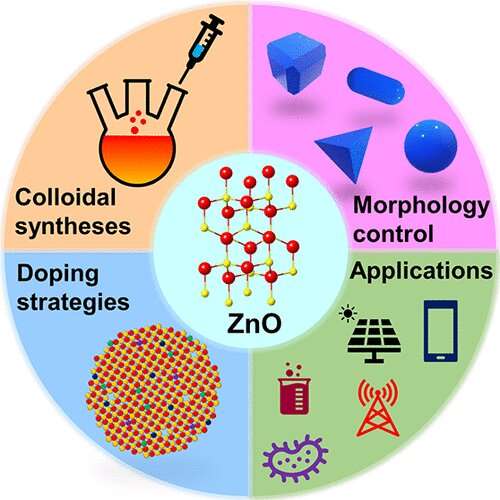Graphical abstract . Credit: Chemical Reviews (2022). DOI: 10.1021/acs.chemrev.2c00456
An international team of scientists is developing an inkable nanomaterial that they say could one day become a spray-on electronic component for ultra-thin, lightweight and bendable displays and devices.
The material, zinc oxide, could be incorporated into many components of future technologies including mobile phones and computers, thanks to its versatility and recent advances in nanotechnology, according to the team.
RMIT University's Associate Professor Enrico Della Gaspera and Dr. Joel van Embden led a team of global experts to review production strategies, capabilities and potential applications of zinc oxide nanocrystals in the journal Chemical Reviews.
Professor Silvia Gross from the University of Padova in Italy and Associate Professor Kevin Kittilstved from the University of Massachusetts Amherst in the United States are co-authors.
"Progress in nanotechnology has enabled us to greatly improve and adapt the properties and performances of zinc oxide by making it super small, and with well-defined features," said Della Gaspera, from RMIT's School of Science.
"Tiny and versatile particles of zinc oxide can now be prepared with exceptional control of their size, shape and chemical composition at the nanoscale," said van Embden, also from RMIT's School of Science.
"This all leads to precise control of the resulting properties for countless applications in optics, electronics, energy, sensing technologies and even microbial decontamination."
Sky's the limit with spray-on electronics
The zinc oxide nanocrystals can be formulated into ink and deposited as an ultra-thin coating. The process is like ink-jet printing or airbrush painting, but the coating is hundreds to thousands of times thinner than a conventional paint layer.
"These coatings can be made highly transparent to visible light, yet also highly electrically conductive—two fundamental characteristics needed for making touchscreen displays," Della Gaspera said.
The nanocrystals can also be deposited at low temperature, allowing coatings on flexible substrates, such as plastic, that are resilient to flexing and bending, the team says.
The team is ready to work with industry to explore potential applications using their techniques to make these nanomaterial coatings.
What is zinc oxide and how can it be used?
Zinc is an abundant element in the Earth's crust and more abundant than many other technologically relevant metals, including tin, nickel, lead, tungsten, copper and chromium.
"Zinc is cheap and widely used by various industries already, with global annual production in the millions of tons," van Embden said.
Zinc oxide is an extensively studied material, with initial scientific studies being conducted from the beginning of the 20th century.
"Zinc oxide gained a lot of interest in the 1970s and 1980s due to progress in the semiconductor industry. And with the advent of nanotechnology and advancement in both syntheses and analysis techniques, zinc oxide has rapidly risen as one of the most important materials of this century," Della Gaspera said.
Zinc oxide is also safe, biocompatible and found already in products such as sunscreens and cosmetics.
Potential applications, other than bendable electronics, that could use zinc oxide nanocrystals include:
- self-cleaning coatings
- antibacterial and antifungal agents
- sensors to detect ultraviolet radiation
- electronic components in solar cells and light emitting devices (LED)
- transistors, which are miniature components that control electrical signals and are the foundation of modern electronics
- sensors that could be used to detect harmful gases for residential, industrial and environmental applications.
Next steps
Scaling up the team's approach from the lab to an industrial setting would require working with the right partners, Della Gaspera said.
"Scalability is a challenge for all types of nanomaterials, zinc oxide included," he said.
"Being able to recreate the same conditions that we achieve in the laboratory, but with much larger reactions, requires both adapting the type of chemistry used and engineering innovations in the reaction setup."
In addition to these scalability challenges, the team needs to address the shortfall in electrical conductivity that nanocrystal coatings have when compared to industrial benchmarks, which rely on more complex physical depositions. The intrinsic structure of the nanocrystal coatings, which enables more flexibility, limits the ability of the coating to conduct electricity efficiently.
"We and other scientists around the world are working towards addressing these challenges and good progress is being made," Della Gaspera said.
He sees great opportunities to collaborate with other organizations and industry partners to tackle these kinds of challenges.
"I am confident that, with the right partnership, these challenges can be solved," Della Gaspera said.
The RMIT team has contributed to other peer-reviewed research on zinc oxide nanocrystals in recent years, including:
- the synthesis of nanocrystals with unprecedented control of their size and chemical composition
- an innovative way to improve the conductivity of coatings at low temperatures
- the use of nanocrystals as antibacterial and antifungal agents.
More information: Joel van Embden et al, Colloidal Approaches to Zinc Oxide Nanocrystals, Chemical Reviews (2022). DOI: 10.1021/acs.chemrev.2c00456
Journal information: Chemical Reviews
Provided by RMIT University























